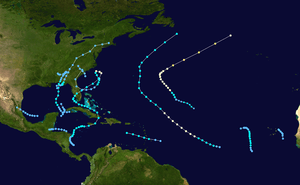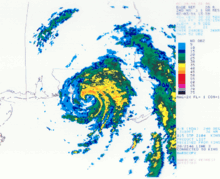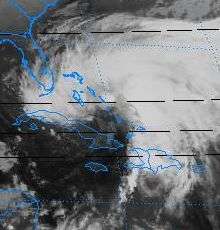Timeline of the 1994 Atlantic hurricane season

The 1994 Atlantic hurricane season was a below-average Atlantic hurricane season that produced seven named tropical cyclones. The season officially began on June 1 and ended on November 30, dates which conventionally limit the period of each year when tropical cyclones tend to form in the Atlantic. The first named storm, Tropical Storm Alberto, formed on June 30. The last storm of the season, Hurricane Gordon, dissipated on November 21. This timeline documents tropical cyclone formations, strengthening, weakening, landfalls, extratropical transitions, as well as dissipation during the season. The timeline also includes information which was not operationally released, such as post-storm reviews by the National Hurricane Center.
This season produced seven named storms; three attained hurricane status, though none became a major hurricane, a storm that ranks as a Category 3 or higher on the Saffir-Simpson Hurricane Scale.[1] Tropical Storm Alberto produced significant rainfall and flooding in the Southeastern United States, damaging or destroying over 18,000 homes, and inflicting $750 million (1994 USD) in damages.[2] In August, Tropical Storm Beryl produced heavy rainfall in areas of Florida, Georgia, South Carolina, and North Carolina, with moderate to heavy rainfall throughout several other states. Beryl caused numerous injuries, many of which occurred from a tornado associated with the tropical storm.[3] Tropical Storm Debby killed nine people throughout its path in September.[4] Hurricane Gordon in November caused damages from Costa Rica to North Carolina in its six landfalls; extreme flooding and mudslides from the storm caused about 1,122 fatalities in Haiti.[5]
Timeline of events

June

- June 1
- The Atlantic hurricane season officially begins.[6]
- June 30
July
- July 1
- 8 p.m. EDT (0000 UTC July 2) – Tropical Depression One strengthens into Tropical Storm Alberto.[7]
- July 3
- July 7
- July 20
- 2 a.m. EDT (0600 UTC) – Tropical Depression Two forms 75 mi (120 km) southeast of Charleston, South Carolina.[8]
- 10 a.m. EDT (1400 UTC) – Tropical Depression Two makes landfall near Georgetown, South Carolina with winds of 35 mph (55 km/h).[8]
- July 21
- 8 a.m. EDT (1200 UTC) – Tropical Depression Two dissipates over southern North Carolina.[8]
August
- August 14
- 8 a.m. EDT (1200 UTC) – Tropical Depression Three forms 165 mi (265 km) southwest of Tallahassee, Florida.[9]
- August 15
- 8 a.m. EDT (1200 UTC) – Tropical Depression Three strengthens into Tropical Storm Beryl.[9]
- 8 p.m. EDT (0000 UTC August 16) – Tropical Storm Beryl makes landfall near Panama City, Florida with winds of 60 mph (95 km/h).[9]
- August 16
- 8 a.m. EDT (1200 UTC) – Tropical Storm Beryl weakens to a tropical depression.[9]
- 8 a.m. AST (1200 UTC) – Tropical Depression Four forms 1,020 mi (1,640 km) south-southwest of Brava, Cape Verde.[10]
- 8 p.m. AST (0000 UTC August 17) – Tropical Depression Four strengthens into Tropical Storm Chris.[10]
- August 18
- 2 a.m. AST (0600 UTC) – Tropical Storm Chris strengthens into a hurricane.[10]
- August 19
- August 20
- 2 a.m. EDT (0600 UTC) – Hurricane Chris weakens to a tropical storm.[10]
- August 23
- 8 p.m. EDT (0000 UTC August 24) – Tropical Storm Chris dissipates as it is merges with an extratropical cyclone southeast of Newfoundland.[10]
- August 29
- 7 a.m. CDT (1200 UTC) – Tropical Depression Five forms 220 mi (355 km) northeast of Veracruz, Mexico.[11]
- August 31
- 1 a.m. CDT (0600 UTC) – Tropical Depression Five makes landfall near Tampico, Mexico with winds of 35 mph (55 km/h).[11]
- 1 p.m. CDT (1800 UTC) – Tropical Depression Five dissipates over the mountains of Mexico.[11]
September
- September 9
- 8 a.m. AST (1200 UTC) – Tropical Depression Six forms 175 mi (285 km) west of Barbados.[12]
- 8 p.m. AST (0000 UTC) – Tropical Depression Six strengthens into Tropical Storm Debby.[12]
- 11 p.m. AST (0300 UTC) – Tropical Storm Debby passes over the island of St. Lucia with winds of 65 mph (100 km/h).[12]
- September 11
- 2 a.m. AST (0600 UTC) – Tropical Storm Debby degenerates into a tropical wave in the eastern Caribbean Sea.[12]
- September 21
- 2 p.m. AST (1800 UTC) – Tropical Depression Seven forms 470 mi (760 km) southwest of Brava, Cape Verde.[13]'
- September 22
- 8 a.m. AST (1200 UTC) – Tropical Depression Seven strengthens into Tropical Storm Ernesto.[13]
- September 24
- September 25
- September 26
- September 27
- 8 a.m. AST (1200 UTC) – Tropical Depression Nine forms 200 mi (320 km) southeast of Praia, Cape Verde.[15]
- September 28
- 8 p.m. AST (0000 UTC September 29) – Tropical Depression Nine dissipates near Sal, Cape Verde.[15]
- September 29
- 2 a.m. EDT (0600 UTC) – Tropical Depression Ten forms 50 mi (85 km) east of Cozumel, Mexico.[16]
- 8 p.m. EDT (0000 UTC September 30) - Tropical Depression Ten enters the Gulf of Mexico.[16]
- September 30
- 2 p.m. EDT (1800 UTC) – Tropical Depression Ten dissipates over open waters.[16]
October
- No tropical cyclones developed during the month of October.[1]
November
- November 1
- 8 p.m. AST (0000 UTC November 2) – A subtropical depression forms 1,020 mi (1,640 km) northeast of Barbuda.[17]
- November 2
- 2 a.m. AST (0600 UTC) – The subtropical depression strengthens into a subtropical storm.[17]
- November 3
- 2 a.m. AST (0600 UTC) – The subtropical storm weakens to a subtropical depression.[17]
- 2 p.m. AST (1800 UTC) – The subtropical depression gains enough tropical characteristics to be declared Tropical Depression Eleven.[17]
- 8 p.m. AST (0000 UTC November 4) – Tropical Depression Eleven strengthens into Tropical Storm Florence.[17]
- November 4
- 2 p.m. AST (1800 UTC) – Tropical Storm Florence strengthens into a hurricane.[17]
- November 7
- November 8
- 8 a.m. EDT (1200 UTC) – Tropical Depression Twelve forms 100 mi (160 km) east of Bluefields, Nicaragua.[18]
- 2 p.m. AST (1800 UTC) – Hurricane Florence weakens to a Category 1 hurricane.[17]
- 8 p.m. AST (0000 UTC November 9) – Hurricane Florence dissipates as it is absorbed by an extratropical cyclone.[17]
- November 10
- 2 a.m. EDT (0600 UTC) – Tropical Depression Twelve makes landfall near Puerto Cabezas, Nicaragua with winds of 35 mph (55 km/h).[18]
- 2 p.m. EDT (1800 UTC) – Tropical Depression Twelve strengthens into Tropical Storm Gordon.[18]
- November 12
- 11 p.m. EDT (0300 UTC November 13) – Tropical Storm Gordon makes landfall near Kingston, Jamaica with winds of 40 mph (65 km/h).[18]
- November 13
- 9 a.m. EDT (1300 UTC) – Tropical Storm Gordon makes landfall near Guantánamo Bay, Cuba with winds of 45 mph (75 km/h).[18]
- November 15
- November 16
- 9 a.m. EDT (1300 UTC) – Tropical Storm Gordon makes landfall near Fort Myers, Florida with winds of 50 mph (85 km/h).[18]
- November 17

- 2 p.m. EDT (1800 UTC) – Tropical Storm Gordon strengthens into a hurricane.[18]
- 8 p.m. EDT (0000 UTC November 18) – Hurricane Gordon reaches its peak intensity with winds of 85 mph (140 km/h) while located 225 mi (365 km) southeast of Wilmington, North Carolina.[18]
- November 18
- 2 p.m. EDT (1800 UTC) – Hurricane Gordon weakens to a tropical storm.[18]
- November 20
- 2 a.m. EDT (0600 UTC) – Tropical Storm Gordon weakens to a tropical depression.[18]
- 11 p.m. EDT (0300 UTC) – Tropical Depression Gordon makes landfall near Cape Canaveral, Florida with winds of 30 mph (45 km/h).[18]
- November 21
- 8 p.m. EDT (0000 UTC November 22) – Tropical Depression Gordon dissipates over South Carolina.[18]
- November 30
- The Atlantic hurricane season officially ends.[6]
Notes
- ↑ The figures for maximum sustained winds and position estimates are rounded to the nearest 5 units (knots, miles, or kilometers), following the convention used in the National Hurricane Center's operational products for each storm. All other units are rounded to the nearest digit.
References
- 1 2 NHC Hurricane Research Division (February 17, 2006). "Atlantic hurricane best track ("HURDAT")". National Oceanic and Atmospheric Administration (NOAA). Retrieved 2008-11-03.
- ↑ National Weather Service. "Tropical Storm Alberto Floods of July 1994 Disaster". NOAA. Retrieved 2008-11-21.
- ↑ Max Mayfield (October 15, 1994). "Tropical Storm Beryl Preliminary Report Page 3". National Hurricane Center. Retrieved 2008-11-21.
- ↑ Edward Rappaport (October 17, 1994). "Tropical Storm Debby Preliminary Report Page 3". National Hurricane Center. Retrieved 2008-11-21.
- ↑ Richard Pasch (January 10, 1995). "Hurricane Gordon Preliminary Report Page 5". National Hurricane Center. Retrieved 2008-11-21.
- 1 2 Atlantic Oceanographic and Meteorological Laboratory, Hurricane Research Division. "Frequently Asked Questions: When is hurricane season?". NOAA. Retrieved 2008-11-03.
- 1 2 3 4 5 Edward N. Rappaport (December 7, 1994). "Tropical Storm Alberto Preliminary Report Page 5". National Hurricane Center. Retrieved 2008-12-20.
- 1 2 3 Richard J. Pasch (January 12, 1995). "Tropical Depression Two Preliminary Report Page 2". National Hurricane Center. Retrieved 2008-12-20.
- 1 2 3 4 5 Max Mayfield (October 15, 1994). "Tropical Storm Beryl Preliminary Report Page 5". National Hurricane Center. Retrieved 2008-12-20.
- 1 2 3 4 5 6 Miles Lawrence (September 21, 1994). "Hurricane Chris Preliminary Report Page 3". National Hurricane Center. Retrieved 2008-12-20.
- 1 2 3 Lixion A. Avila (October 4, 1994). "Tropical Depression Five Preliminary Report Page 2". National Hurricane Center. Retrieved 2008-12-20.
- 1 2 3 4 Edward N. Rappaport (October 17, 1994). "Tropical Storm Debby Preliminary Report Page 5". National Hurricane Center. Retrieved 2008-12-20.
- 1 2 3 4 Richard J. Pasch (October 27, 1994). "Tropical Storm Ernesto Preliminary Report Page 3". National Hurricane Center. Retrieved 2008-12-20.
- 1 2 3 Max Mayfield (October 10, 1994). "Tropical Depression Eight Preliminary Report Page 2". National Hurricane Center. Retrieved 2008-12-20.
- 1 2 Miles Lawrence (January 17, 1995). "Tropical Depression Nine Preliminary Report Page 1". National Hurricane Center. Retrieved 2008-12-20.
- 1 2 3 Lixion A. Avila (October 25, 1994). "Tropical Depression Nine Preliminary Report Page 2". National Hurricane Center. Retrieved 2008-12-20.
- 1 2 3 4 5 6 7 8 9 10 Edward N. Rappaport (December 8, 1994). "Hurricane Florence Preliminary Report Page 4". National Hurricane Center. Retrieved 2008-12-20.
- 1 2 3 4 5 6 7 8 9 10 11 12 13 Richard J. Pasch (January 10, 1995). "Hurricane Gordon Preliminary Report". National Hurricane Center. Retrieved 2010-11-24.
| Preceded by 1992 |
Atlantic hurricane seasons timelines 1994 |
Succeeded by 1995 |